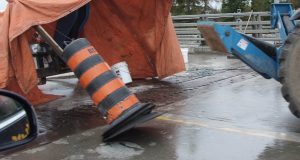Sep 26, 2016 @ 23:59
For eight months, the people of Ontario have patiently waited for the government to restore their faith in the safety of our Provincial Highway System by releasing reports of the investigation into the January 2016 failure of the Nipigon River Bridge. The Government assured the public that these reports would be released only when a comprehensive review of all the factors contributing to the failure was completed.
Engineering at its heart is as much art as science. Its practice is as imperfect as those of us who ply its trade despite the burden of responsibility we bear and the tireless efforts made to ensure our failings such as they are, are brought to light and corrected before the results can be disastrous.
That is why good engineering is not so much about perfect designs and never making mistakes as it is about putting the knowledge, experience and safeguards in place so mistakes are identified, corrected and mitigated. Likewise, a good investigation must identify the technical aspects of the sequence of events occurred that resulted in an engineering failure, why these events occurred and what safeguards failed to identify, correct, and mitigate these mistakes.
Upon first review, the engineers responsible for the Nipigon reports must be commended for the thorough and complete work they have undertaken in fulfilling their mandate in identifying what occurred.
However, it is clear that the mandate was not comprehensive to include examination of the processes or safeguards that failed to prevent the unfortunate sequence of events despite numerous decision points in the process where sufficient expertise may have identified the dangers prior to the failure.
Indeed the scope of the investigation seems to preclude examining the Ministry’s own role in the unfortunate series of events from the outset. Most telling is one simple line from the Ministry of Transportation’s own Bridge Office; “Factors dealing with management of the project are not the subject of this report.”
The power of adequate oversight cannot be overstated
Both the independent and Ministry reports for Nipigon identify a number of such events where proper oversight could have forestalled the future failure including: review of Contract and Specification requirements for the bearings; review of Requests for Clarification for the design of the bearing; review of the bearing fabrication drawings; review of the non-conformances related to the length of the bolts, the improper installation of the bolts; the failure to tighten the bolts, and most importantly the opening of the bridge to traffic prior to the correction of the non-conformance related to the bolt lengths.
Any and all of these events represented an opportunity for oversight and potential intervention that with the right expertise could have prevented the series of events that ultimately led to the failure of the hold-down bearing. It is only by good fortune that the north bearing on the leaving end failed first and avoided potential injury from an imminent failure of the centre bearing, which would have resulted in a collision with the raised end of the bridge.
For years, PEGO and its members have been advocating to both senior management and government that our current system for oversight of external construction contracts is inadequate. We have abdicated the traditional Ministry role of Quality Assurance and placed blind faith in the Quality Control processes of project companies and specifically in the certification of works by Quality Verification Engineers (QVE) employed directly by the project companies. Just as the 500 girders rejected in Windsor were certified as conforming to contract requirements so too was the construction at Nipigon. It is time we learned from our mistakes.
Every building constructed in Ontario is done so under the oversight of the local building department. From the smallest house to the largest hospital, Occupancy Permits are required prior to allowing use by the property owner or the public, yet we allow hundreds of thousands of people a day to use new bridges without any independent authority assuring they are suitable prior to opening to traffic. The people of Ontario deserve similar processes and safeguards in the construction of their bridges and highways.
In the recent construction of the Herb Gray Parkway, the diligence of our members during one site visit identified un-approved welding of reinforcing for the main girders. The resulting investigation, in which our members supervised the demolition of girders identifying deficiencies in the construction, eventually resulted in the rejection of over 500 non-conforming girders and ensured the safety of the Parkway.
The government is aggressively pursuing an infrastructure program that is unprecedented in its magnitude and complexity. Despite ten-fold increases in infrastructure funding government, engineering resource levels have remained static in favour of Alternative Financing and Procurement models. Increasingly, project companies are making decisions about the type and quality of infrastructure once made by government engineers with the long-term interests of the people of Ontario in mind. The government no longer has the engineering resources or expertise to properly oversee the work it tenders.
The recent Charbonneau Commission in Quebec, identified the need for more engineers at the Ministry of Transportation of Quebec (MTQ) to effectively oversee construction and maintenance of highways and bridges. There are currently over 800 engineers working for MTQ maintaining an inventory of over 4000 bridges whereas currently MTO has approximately 350 engineers for 2800 bridges. The MTO’s management of the infrastructure program has been rightly characterized by the Grievance Settlement Board Arbitration Decision as, “an embarrassment of riches coupled with a poverty of staff”.
Further, the eight months lost in the preparation and the release of these reports, has, disappointingly, due to the limited scope of the reviews, not resulted in any recommendations that will prevent similar failures in the future, nor has the Ministry taken any independent action to avoid these issues on other projects.
The path forward
To reverse the erosion of oversight and help prevent future infrastructure failures, a number of measures must be implemented in both the short and long term including:
- Establish an independent Office of the Chief Engineer of the Province of Ontario reporting to the legislature to perform audits of the government’s delivery of engineering services, provide oversight and advice to the government on engineering issues, fulfill the regulatory approval functions required under various legislation, and independently investigate engineering failures like Nipigon and the Algo Mall.
- Provide Legislative Authority to Government Engineers similar to that afforded Building Officials and Engineers with the Ministry of Labour to ensure compliance with Legislation and Regulation for Highway Infrastructure.
- Review the Quality Control (including QVE) and Quality Assurance processes at the Ministry of Transportation to ensure the Contractors obligations are carried out adequately and that a minimum acceptable level of oversight is provided.
- Implement Regulatory process including a permit approval requirement prior to allowing traffic on any bridge during any stage of construction
- Provide government engineering resources required to ensure the required level of oversight.
- Provide immediate communication to all Ministry Staff, Municipalities, engineering consultants and Ministry Contractors in the Province informing them of the nature of the failure and the importance of pre-tensioning high strength bolts for highway structures prior to opening to traffic.
PEGO believes these steps, when coupled with appropriate level of engineering resources, can form part of a sustainable plan to deliver the infrastructure needs of Ontario now and in the future. We would further echo the recent comments from the Ontario Society of Professional Engineers that the expertise and experience of both public and private sector engineers must be leveraged with a seat at the policy-making table to ensure important government works are founded on sound engineering principles.
Professional Engineers Government of Ontario (PEGO) is the Association representing the approximately 600 Professional Engineers and Ontario Land Surveyors employed by the Government of Ontario.
- Saturday Morning News – December 13 - December 13, 2025
- Hwy 17 (Wawa to Batchawana) CLOSED - December 13, 2025
- Friday Morning News – December 12th - December 12, 2025
 Wawa-news.com You can't hear the 'big picture'!
Wawa-news.com You can't hear the 'big picture'!

